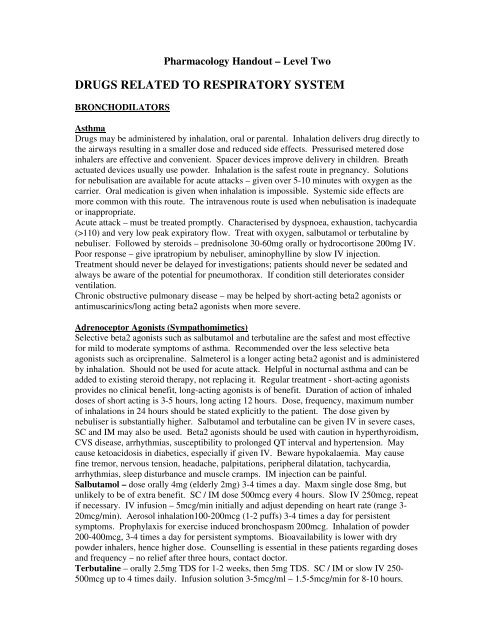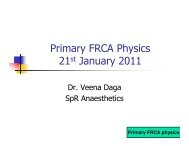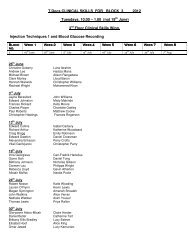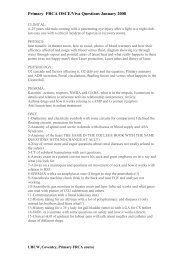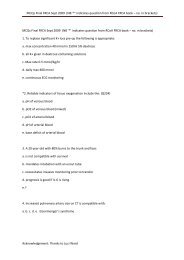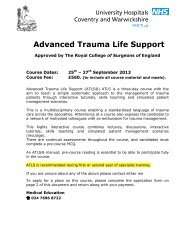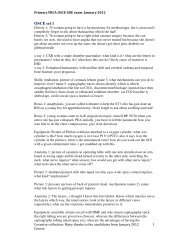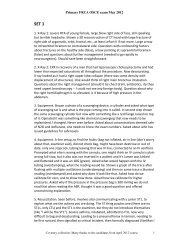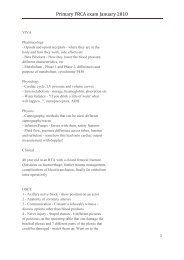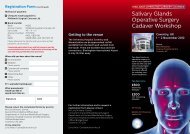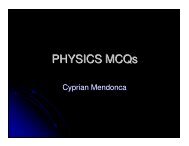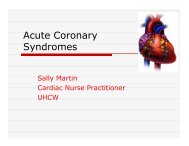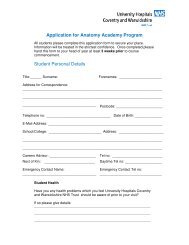DRUGS RELATED TO RESPIRATORY SYSTEM
DRUGS RELATED TO RESPIRATORY SYSTEM
DRUGS RELATED TO RESPIRATORY SYSTEM
Create successful ePaper yourself
Turn your PDF publications into a flip-book with our unique Google optimized e-Paper software.
Aerosol 250-500mcg 3-4 times a day for persistent symptoms. Powder 500mcg (oneinhalation) four times a day. Nebulised 5-10mg 2-4 times daily. Counselling is essential inthese patients regarding doses and frequency – no relief after three hours, contact doctor.Salmeterol – main use in patients who require long term regular bronchodilator treatment, notfor immediate relief in acute attacks. Significant incidence of paradoxical bronchospasm.Dose by inhalation 50mcg (2 puffs) BD in severe airways obstruction. Same dose for COAD.KEY POINTS – BRONCHODILA<strong>TO</strong>RS1. Two main types – beta2 adrenoceptor stimulants and antimuscarinics (anticholinergics)2. Some are given by inhalation – patients being given detailed instructions on devices3. Bronchodilators with a long action are not suitable for treatment of acute attacks4. Hypokalaemia is a potential risk with beta2 adrenoceptor stimulants5. Hypokalaemia can be increased with combined therapies – monitor plasma potassiumAnti-muscarinicUsed by inhalation in patients already on high dose inhaled steroids. Can be nebulised in lifethreatening situations. More effective in relieving bronchoconstriction in COAD than inrelieving asthma. Aerosol ipratropium has a maximum effect 30-60 mins after use with aduration of action 3-6 hours. Maintenance three times per day.Ipratropium - caution in patients with glaucoma, prostatic hypertrophy. Be carefulnebulised drug does not enter eye in glaucoma patients. Causes dry mouth, urinary retentionand constipation. Aerosol 20-40mcg up to 80mcg, 3-4 times per day. Inhalation of powder40mcg, 3-4 times per day, doubled in less responsive patients. Nebulised 100-500mcg up to 4times per day. Because of paradoxical bronchospasm first dose under medical supervision.TheophyllinesUsed in reversible airways obstruction. Additive effect when given with beta2 agonist,including hypokalaemia. Theophylline is metabolised in the liver and considerable variationin half life occurs. Half life increases in heart failure, cirrhosis, viral infections, elderly andconcurrent treatment with cimetidine, ciprofloxacin, erythromycin, fluvoxamine and oralcontraceptives. Half life is decreased in smokers, chronic alcoholism and by drugs such asphenytoin, carbamazepine, rifampicin and barbiturates. This is important because of thenarrow margin between therapeutic and toxic levels. A plasma theophylline level of between10-20mg/litre is usually required for effective bronchodilatation. Frequency and severity ofside effects increase with levels over 20mg/litre. Theophylline modified release preparationscan produce adequate plasma levels for up to 12 hours. Given at night it can control nocturnalasthma and early morning wheezing. Theophylline is given by injection as aminophylline – amixture of theophylline and ethylenediamine, which is 20 times more soluble thantheophylline alone. Aminophylline must be given by very slow IV injection (at least 20mins). It is too irritant for IM use. IV aminophylline is useful when nebulised beta2 agonistshave failed to work. Essential to measure levels in patients taking oral theophylline before IVaminophylline – convulsions and arrhythmias can occur.Theophylline – caution with heart disease, hyperthyroidism, peptic ulcer, hepatic impairment,epilepsy, elderly, fever. Avoid in porphyria. Beware hypokalaemia. Side effects includetachycardia, palpitations, nausea, headache, CNS stimulation, insomnia, arrhythmias andconvulsions – especially if given by rapid IV injection. Doses of the five preparations varyand the patient must receive the one that they are already taking. Neulin 125mg 3-4 times aday after food; Neulin SA 175-350mg 12 hourly; Slo-Phyllin 250-500mg 12 hourly; Theo-Dur 300mg 12 hourly; Uniphyllin Continus 200mg 12 hourly increasing to 300mg after oneweek. Beware some cough and decongestants contain theophylline.
Aminophylline – allergy to ethylenediamine may cause urticaria, erythema and exfoliativedermatitis. Orally 100-300mg 3-4 times per day after food. Intravenously, if not already ontheophylline, give 250-500mg (5mg/kg) by slow injection over 20 minutes. Infusion500mcg/kg/hr, adjusting to plasma levels. If already on oral theophylline DO NOT give IVaminophylline unless plasma level available.CorticosteroidsAre effective in asthma by reducing airway inflammation and hence reducing oedema andsecretion of mucus in the airways. Patients with COAD usually show no response tocorticosteroids. Higher doses of inhaled corticosteroid may reduce symptoms andexacerbations slightly in patients with more severe COAD. Trial of corticosteroid candistinguish between COAD and asthma. Inhaled corticosteroids should be considered forprophylactic treatment of asthma when patients are using beta2 agonists more than once daily.Corticosteroid inhalers must be used regularly to obtain maximum benefit. Alleviation ofsymptoms occurs 3-7 days after initiation. Doses for CFC free corticosteroids may bedifferent from those containing CFC’s. If inhaled corticosteroid causes coughing, a beta2agonist beforehand may help. Transfer from oral corticosteroids to inhaled must be slow witha gradual reduction in oral dosage. High dose inhalers (500mcg BD) should only be used ifthere is clear benefit over the lower dose. Oral tablets may be needed during infection andexacerbations. Inhaled corticosteroids have considerably fewer systemic side effects than oralsteroids. Prolonged high doses can cause glaucoma and cataracts. Higher doses have thepotential to induce adrenal suppression and should receive cover during stress episodes. Longterm high dose can cause bone demineralisation and osteoporosis. Spacer devices increaseairway deposition and decrease oropharyngeal deposition which predisposes to candidiasis.Oral steroids for acute attacks over a short course – 30-60mg prednisolone daily for a fewdays. Dose reduced gradually after attack controlled. Long term steroids may be necessary inpatients where response to other drugs is small. High dose inhalation is preferred to minimiseoral intake of steroids. Oral should be given as single dose in the morning to reducedisturbance to circadian cortisol secretion. Titrated to lowest dose to control symptoms.Regular peak flow readings. Alternate day treatment is not very effective.Beclomethasone – caution in active or quiescent tuberculosis, cover may be required duringstress episodes (operation). Paradoxical bronchospasm can occur and may be prevented byinhalation of beta2 agonist. Can cause hoarseness, candidiasis (mouth and throat). Dose byaerosol 200mcg BD or 100mcg TDS/QDS. Powder 400mcg BD or 200mcg TDS/QDS. Highdose inhalers 500mcg BD or 250mcg QDS, increasing to 500mcg if necessary. Powder400mcg BD, increasing to 800mcg BD.Leukotriene receptor antagonistsBlock the effect of cysteinyl leukotrienes in the airways. Add on therapy for patients withmild to moderate asthma which is not controlled with inhaled corticosteroids and a shortacting beta2 agonist. May be of benefit in exercise induced asthma. Should not be used totreat acute severe asthma. Churg-Strauss syndrome – history of asthma, rhinitis, sinusitis,systemic vasculitis, eosinophilia – can be associated with use of leukotriene receptorantagonists. Often triggered by reduction or withdrawal of oral corticosteroid therapy. Theprescriber must make the patient aware of potential symptoms of eosinophilia, vasculitic rash,worsening pulmonary symptoms, cardiac complications or peripheral neuropathy.Zafirlukast – caution in the elderly, renal impairment, Churg-Strauss syndrome, hepaticimpairment. Interacts with aspirin (increases levels zaf), erythromycin and theophylline(decreases levels of zaf), anticoagulant effect of warfarin increased. Can cause GIT
antibiotic may occur. If no organism is cultured then clinical grounds are used for decisionmaking.KEY POINTS – ANTIBIOTIC THERAPY1. Antibiotics are antibacterial, not antiviral agents2. Nature of infective organism and sensitivity to antibiotics before treatment, if possible3. Broad spectrum combinations not a good substitute for tailored treatment to organism4. Know previous treatment and hypersensitivities, hepatic and renal function5. Route of administration and duration depend on severity of infection6. Topical use of antibiotics should be avoidedPenicillinsAre bactericidal and act by interfering with bacterial wall synthesis. Diffuse well into bodytissues but penetration of CSF is poor (unless meninges inflamed). Excreted in urine intherapeutic concentrations. Most important side effect is hypersensitivity – rashes andanaphylaxis. If they have suffered anaphylaxis, urticaria or rash immediately after penicillinadministration then they are at increased risk of immediate hypersensitivity to penicillin.They should not receive a beta-lactam antibiotic. A minor rash, or one which develops after72 hours after penicillin is probably not allergic to penicillin and it should not be withheld inserious infections. A rare but serious toxic effect is encephalopathy due to cerebral irritation.May be due to excessively high doses in patients with renal failure. Should not be givenintrathecally. There can be accumulation of electrolyte in renal failure patients. Diarrhoea isfrequent. MRSA can be resistant to flucloxacillin as well, give vancomycin or teicoplanininstead.Benzylpenicillin – is inactivated by bacterial beta-lactamases. Effective in streptococcal,pneumococcal, meningococcal and gonococcal infections. Also for anthrax, diphtheria, gasgangrene,leptospirosis and Lyme disease. It is inactivated by gastric acid and absorption islow. Phenoxymethylpenicillin is gastric stable. Beware allergy and renal impairment. Sideeffects – hypersensitivity, neutropenia, thrombocytopaenia, convulsions, diarrhoea and colitis.IM or slow IV injection 2.4-4.8g daily in four divided doses. Meningococcal diseae 2.4gevery four hours IV.Flucloxacillin – effective against penicillinase producing staphylococci – sole indication foruse. Can be given orally and by injection. Cholestatic jaundice has been seen several weeksafter stopping flucloxacillin. Administration for longer than 2 weeks and age can increasethe risk. Same side effects as benzylpenicillin. Dose 250-500mg QDS at least 30 minutesbefore food. Similar for IM. Slow IV of 250-2000mg every six hours.Amoxicillin – active against Gram negative and positive organisms. Inactivated bypenicillinase. Should not be used blind in hospital acquired infection without checkingsensitivity. Well excreted in bile and urine. Given orally, absorption is better than ampicillinand is not decreased if there is food in the gut (ampicillin reduced absorption). Bewareallergy and renal impairment. Causes rash, especially if glandular fever. Nausea, vomiting,diarrhoea, rash. 250mg orally TDS, doubled in severe infection. IM 500mg every 8 hours.IV same as IM but up to 1g every six hours.Co-amoxiclav – amoxicillin plus beta-lactamase inhibitor clavulanic acid (no significantantibacterial activity). Should be reserved for infection caused by amoxicillin resistantorganisms. Same side effects as amoxicillin as well as cholestatic jaundice, erythemamultiforme, vasculitis, headache, convulsions. 250mg orally TDS, doubled in severeinfection. IV injection over 3-4 minutes, 1g TDS.
Co-fluampicil – mixture of equal parts of flucloxacillin and ampicillin. Use in mixedinfections involving beta-lactamase producing staphlycocci. Oral dose 250/250mg every 6hours, doubled in severe infection. Same for IM and slow IV.Piperacillin – is a ureidopenicillin broad spectrum, more active than ticarcillin againstpseudomonas. Should be used with an aminoglycoside in the treatment of pseudomonassepticaemia – synergistic effect. Should NOT be mixed in the same syringe or infusion. Maylead to hypernatraemia. Same side effects as benzylpenicillin. Deep IM or slow IV over 3-5minutes 100-150mg/kg daily up to 200-300mg/kg in divided doses.CephalosporinsBroad spectrum antibiotics used for septicaemia, pneumonia, meningitis, biliary tractinfection, peritonitis and UTI. Similar pharmacology to penicillins, excretion being mainlyrenal. Penetrate CSF poorly (unless inflamed meninges). Cefotaxime suitable cephalosporinfor infections of CNS. 10% of penicillin sensitive patients will be sensitive to cephalosporins.Interference with clotting.Cefotaxime – greater activity against certain Gram negative bacteria. Less active thancefuroxime against Gram positive bacteria. Can get superinfection with resistant bacteria andfungi. Beware renal impairment, false positive glucose test and Coombs test. Contraindicatedin cephalosporin sensitivity and porphyria. Diarrhoea, colitis, N&V, abdominal discomfort,hepatic disturbance, blood disorders. IM or IV injection 1g every 12 hours increasing insevere infections up to 8g daily.Cefuroxime – less susceptible to beta-lactamase inactivation. Same side effects ascefotaxime. Orally 250mg BD, doubled for severe infection. UTI 125mg BD, pyelonephritis250mg BD. IM/IV 750mg every 6-8 hours, 1.5g in severe infections. Surgical prophylaxis1.5g IV at inductionCephalexin – active orally. Useful for UTI. Same side effects as cefotaxime. Orally 250mgQDS or 500mg every 8-12 hours increasing to 1-1.5g every 6-8 hours.Aztreonam – is a monocyclic beta-lactam antibiotic with an antibacterial spectrum limited toGram negative aerobic bacteria, not active against Gram positive and should not be usedblind. Less likely to cause hypersensitivity in penicillin sensitive patients. Reduce dose inrenal impairment, beware hepatic impairment. N&V, diarrhoea, cramps, mouth ulcers,jaundice, blood disorders, urticaria and rashes. Deep IM or IV injection over 3-5 minutes 1gevery 8 hours or 2g every 12 hours.KEY POINTS – CEPHALOSPORINS1. Bacteriocidal antibiotics with wide range of activity2. Some are less susceptible to inactivation by beta-lactamases3. Main side effect hypersensitivity and 10% penicillin sensitive patients are also sensitive4. Exclude such sensitivity before cephalosporin therapyTetracyclinesBroad spectrum antibiotic which has developed resistance. Treatment of choice forchlamydia, rickettsia, brucella and spirochaete. Respiratory mycoplasmal infection andbronchitic exacerbations. Useful in acne. Tetracyclines are deposited in growing bone andteeth causing staining and dental hypoplasia – do not use in children under 12 years orpregnant women. With the exception of doxycycline, tetracyclines exacerbate renal failure.Tetracycline – chronic bronchitis. Beware hepatic and renal impairment. Can cause N&V,diarrhoea, oesophageal irritation, exacerbation SLE and myasthenia gravis. 250mg QDSorally, doubling in severe infection.
Doxycycline – brucellosis, prostatitis. May be used in renal impairment. Avoid in porphyriaand exposure to sunlight. Orally 200mg first day then 100mg daily.KEY POINTS – TETRACYCLINES1. Broad spectrum antibiotics, limited by bacterial resistance2. Use in infections caused by chlamydia, rickettsia and mycoplasma3. Tetracyclines bind with calcium and deposited in teeth, avoid children
Erythromycin – caution in hepatic and renal impairment, prolongation of QT interval,porphyria. Urticaria, rash, reversible hearing loss with large doses, cholestatic jaundice andcardiac effects. 250-500mg QDS up to 4g daily in severe infections. IV infusion 50mg/kgdaily every 6 hours.KEY POINTS – MACROLIDES1. Penicillin like range of activity2. Useful in penicillin sensitive patients3. Useful against some penicillin resistant staphlycocciOthersChloramphenicol – potent broad specrum but can cause serious haematological side effectswhen given systemically. Reserve for life threatening conditions such as typhoid. Avoidrepeat courses and prolonged treatment. Reduce dose in hepatic and renal impairment. Sideeffects – irreversible aplastic anaemia, peripheral neuritis, optic neuritis, erythemamultiforme, N&V, diarrhoea, grey syndrome (abdominal distension, cyanosis and circulatorycollapse). Orally or IV – 50mg/kg in 4 divided doses, can be doubled in severe infections.Pre-dose levels should not exceed 15mg/L.Clindamycin – causes colitis, especially in middle aged to elderly women post-operative. Ifdiarrhoea starts discontinue drug immediately. Active against Gram positive cocci. Wellconcentrated in bone and excreted in bile and urine. Recommended for staph joint and boneinfection. Caution with hepatic or renal impairment. Diarrhoea, N&V, colitis, jaundice,blood disorders. Orally 150-300mg every 6 hours, up to 450mg every 6 hours in severeinfections. Deep IM or IV infusion – 0.6-2.7g daily in 2-4 divided doses. Single dose IVshould not exceed 1.2g.Fucidin – narrow spectrum antibiotic. Used in treatment of penicillin resistant staphinfections, especially osteomyelitis. Use with another antibiotic to prevent resistancedeveloping. Beware hepatic impairment. Can cause N&V, reversible jaundice (after highdose or rapid injection), rash, acute renal failure and blood disorders. Orally 500mg TDS,doubled for severe infection. IV 500mg TDS, less than 50kg give 6-7mg/kg TDS daily.Vancomycin – bacteriocidal against aerobic and anaerobic Gram positive bacteria. Used IVagainst multi-resistant staph. Long duration of action, 12 hourly. Plasma levels after 3-4doses, renal impairment sooner. Ototoxic and nephrotoxic. Not effective by mouth in seriousinfection – not significantly absorbed. Can be used to treat antibiotic associated colitis –orally 125mg QDS 7-10 days. When given IV avoid rapid infusion. Caution in renalimpairment, elderly, history of deafness – blood counts, urinalysis, renal function tests in allpatients. Blood disorders – neutropenia – after one week or cumulative dose of 25g. IVinfusion 500mg over 60 minutes QDS or 1g over 200 mins every 12 hours.Teicoplanin - bacteriocidal against aerobic and anaerobic Gram positive bacteria. Similar tovancomycin, but significantly longer duration of action, hence daily doses. Can be given IMor IV. Monitor auditory and renal function. N&V, diarrhoea, rash, pruritis, bronchospasm,blood disorders, abn. liver function tests, tinnitus and renal failure. IV/IM 400mg every 12hrsfor three doses, then 200mg daily. Higher dose in patients over 85kg.Colistin – polymixin antibiotic active against Gram negative organisms. Not absorb orallyand is toxic IV. Mainly used for bowel sterilisation, but not for bowel infections. Can benebulised. Caution in renal impairment and porphyria. Contraindicated in myasthenia gravis.Can cause perioral and peripheral paraesthesia, vertigo, muscle weakness, nephrotoxicity,bronchospasm. Orally 1.5 to 3 million units TDS. IM/IV 2 million units TDS. Inhalation 1million units every 12 hours.
Co-trimoxazole – sulphamethoxazole + trimethoprim synergistic. Can cause StevensJohnson syndrome and blood dyscrasias. Caution in renal and hepatic impairment, avoid inblood disorders (monitor blood count), discontinue if rash or blood disorder. Contraindicatedin porphyria. N&V, rash, SLE, anorexia, arthralgia, liver damage, pancreatitis, renalproblems. 960mg orally every 12 hours, same IV. Increase to 1.44g in severe infection.Trimethoprim – for urinary and respiratory infections. Side effects less severe when usedalone (without sulphamethoxazole). Orally 200mg every 12 hours, slow IV 200mg every 12hours.KEY POINTS – SULPHONAMIDES1. High fluid intake necessary to avoid crystalluria2. Best avoided in the elderly and patients with folate deficiency3. Trimethoprim preferred for most infectionsMetronidazole – high activity against anaerobic bacteria and protozoa. Used in treatment ofantibiotic associated colitis (400mg orally TDS). Disulfarim-like reaction with alcohol.Beware hepatic impairment, monitor if treatment exceeds 10 days. N&V, unpleasant taste,headache, urticaria, abnormal LFT’s, aplastic anaemia. Anaerobic infection 800mg orallythen 400-500mg TDS. IV 500mg every 8 hours. PR 1g every 8 hours.QuinolonesActive against Gram negative and positive bacteria. Respiratory and UTI. Should be usedwith caution in patients with a history of epilepsy and myasthenia gravis. Avoid exposure toexcessive sunlight. Taking NSAID’s at same time might predispose to convulsions. Cancause arthropathy in adolescents.Ciprofloxacin – N&V, dyspepsia, convulsions, arthralgia, tendonitis, renal failure andhepatic dysfunction. Orally 250-750mg BD for respiratory, 250-500mg UTI for three days.IV 400mg over 60 minutes, 200-400mg BDKEY POINTS – QUINOLONES1. Ciprofloxacin has widest range of activity, effective against Gram +ve and –ve pathogens2. Use with caution in epileptics – may cause convulsions3. Action may increase if NSAID’s are also taken4. Withdraw treatment if neurological or other disturbances occur after first doseAnti-malarialChloroquine is used for the prophylaxis of malaria in areas of the world where the risk ofchloroquine-resistant falciparum malaria is still low. It is no longer recommended astreatment because of widespread resistance.Chloroquine – caution in renal impairment and pregnancy. May exacerbate psoriasis andneurological disorders. Side effects include GIT disturbance, headache, convulsions, marrowsuppression, urticaria. Dose 300mg weekly.Anti-fungalAspergillosis usually respiratory tract and treated by IV amphotericin. Candidiasis can betreated topically but deep seated infection needs IV amphotericin or fluconazole.Cryptococcus in immunocompromised patients needs IV amphotericin or fluconazole.Histoplasmosis – fulminating give amphotericin IV.Amphotericin – used in systemic fungal infections. Active against most fungi and yeasts.Highly protein bound and penetrates tissues poorly. Given IV side effects common. Monitor
hepatic and renal function, blood count and electrolytes. Arrhythmias if infused rapidly.Anorexia, N&V, anaphylaxis (test dose first), low potassium and magnesium, blood disorders,neurological disorders. Orally 100-200mg QDS. IV 1mg over 15 minutes then 5mg/kg dailyfor at least 14 days.Fluconazole – well absorb orally and good penetration into CSF. Beware renal and hepaticimpairment. Nausea, diarrhoea, headache, rash, abnormal LFT’s, alopecia, pruritis. Oral150mg single dose in thrush. Mucosal candidiasis 50mg daily for 7-14 days. IV 400mginitially then 200mg daily.Nystatin – mainly for candida infections. N&V, diarrhoea, rash, oral irritation. Orally500,000 units QDS, doubled in severe infection.Miconazole – for oral infections and intestinal. Oral gel can result in systemic absorption.Beware hepatic impairment. N&V, diarrhoea and hepatitis. 5-10mls in the mouth after foodevery six hours.KEY POINTS – ANTIFUNGAL AGENTS1. When used for oral fungal infections, remove dentures2. Dermatophyte infection of hair, remove as much infected hair as possible3. Combined use of azole antifungal agents and astemizole, ccisapride and terbinafine mayresult in cardiac arrhythmias4. Should not be used for superficial fungal infectionsAnti-viralMajority of viral infections resolve spontaneously in immunocompetent subjects.Aciclovir – active against herpes virus. Does not eradicate virus. Systemic treatment ofchickenpox and shingles, topical treatment of herpes simplex infections (inc eye). Maintainadequate hydration, beware renal impairment. N&V, diarrhoea, fatigue, rash, urticaria,hepatitis, neurological symptoms, renal failure. 200mg five times daily orally for treatment ofherpes simplex – 5 days. Herpes zoster – 800mg five times daily for 7 days. IV infusion5mg/kg TDS for 5 days.Famciclovar – pro-drug of penciclovir. Used in herpes zoster and genital herpes. Used ascream. N&V, headache, confusion, rash. 250mg TDS for 7 days in herpes zoster. Genitalherpes same but 5 day course.Valganciclovir – induction and maintenance treatment of CMV in AID’s patients. Pro-drugof ganciclovir. Monitor blood count. Side effects N&V, diarrhoea, leucopaenia, anaemia,GIT bleed. 900mg twice daily for 21 days; if retinitis worsens repeat 21 day course.Maintenance 900mg daily.KEY POINTS – ANTIVIRAL AGENTS1. Mainly virustatic, not virucidal in action2. Early treatment necessary3. Some are inactivated by gastric acid and should be taken fasting or between meals4. Some given by injection are skin irritants – avoid direct skin contactHIV INFECTIONThe most frequently used treatment regimens include a protease inhibitor combined with twonucleoside analogue reverse transcriptase inhibitors (e.g saquinavir with zidovudine andzalcitabine). Such combinations are referred to as highly active antiretroviral therapy(HAART) and involve complex regimens that require compliance by the patient and carefulassessment of the progress of viral suppression. Combination drug therapy should be startedbefore substantial immunodeficiency is present. The goal is to suppress the virus before
esistant mutants emerge or irreversible immune damage occurs. When resistance occurs,changes in drug therapy should involve the addition or change of at least two drugs. Optimaltreatment should reduce the viral load to below detectable limits. This may take six monthsof adequate therapy to achieve. Failure to achieve full suppression of viral load shouldprompt a change in therapy if compliance is believed to be good. Poor compliance is likely toencourage the development of drug resistance. Prophylaxis after accidental exposure to thevirus is now recommended. The regimen depends on the level of risk: two drugs are oftenused for moderate risk or three drugs if the risk is high.TUBERCULOSISTB is treated in two phases – initial phase using at least three drugs and a continuation phaseusing two drugs in fully sensitive cases. Initial phase reduces the bacterial population asrapidly as possible and prevents the emergence of drug-resistant bacteria. Daily use ofisoniazid, rifampicin, pyrazinamide and ethambutol is the treatment of choice, preferably as asingle tablet. Ethambutol can be omitted if risk of resistance to isoniazid is low. Bewareimmunosuppressed patients, those previously treated for TB and those who have had contactwith drug resistant TB. Streptomycin can be used in resistant cases. Initial phase drugsshould be continued for 2 months and then until susceptibility results are known.Continuation phase – for a further 4 months with isoniazid and rifampicin, preferably ascombination drug. Rifater is a combination drug – rifampicin, isoniazid and pyrazinamide.Rifinah is rifampicin and isoniazid. Supervised treatment is isoniazid, rifampicin,pyrazinamide and ethambutol 3 times a week for 2 months followed by isoniazid andrifampicin 3 times a week for four months. Care with immunocompromised patients –resistance is common. Monitor hepatic function in all patients and check renal functionbefore dose calculation. Isoniazid is a cheap and highly effective drug. Can cause peripheralneuropathy – if it develops gives pyridoxine 10mg daily. Rifampicin can cause disruption toLFT’s, usually transient. Six syndromes with intermittent treatment (20-30% cases) – flu like,abdominal and respiratory symptoms, shock, renal failure and thrombocytopaenia purpura. Itinduces liver enzymes. Pyrazinamide is bactericidal and is only useful in the first couple ofmonths. Ethambutol if isoniazid resistance. Visual disturbance, colour blindness, decreasedacuity, restriction of fields. Eyesight usually recovers on stopping the drug.Isoniazid – beware renal and hepatic impairment. Slow acetylators are at risk from toxicity.Alcoholics, malnourished, HIV and diabetics a risk from neuropathy. Side effects – N&V,dry mouth, neuropathy, convulsions, psychosis, SLE like syndrome. Dose 300mg daily.Rifampicin – beware hepatic and renal impairment, porphyria. Failure of oral contraceptive.Discolouration of tears and contact lenses. Side effects – GIT (N&V, diarrhoea), flu likesymptoms, anaemia, renal failure, thrombocytopaenic purpura. Dose 450-600mg daily.Pyrazinamide – beware hepatic impairment, gout and diabetes. Side effects – hepatotoxicitywith fever, anorexia, hepato-spleno-megaly, jaundice, N&V and arthralgia. Dose 1.5 to2grams daily.Ethambutol – beware renal function, visual acuity. Side effects – optic neuritis, visualdisturbance. Dose 15mg/kg daily.Rifater - isoniazid, rifampicin and pyrazinamide. Under 40kgs (3 tabs daily), 40-49kgs (4tabs daily), 50-64kgs (5 tabs daily) and over 65kgs (6 tabs daily).Rifinah – isoniazid and rifampicin. Under 50kgs (3x150mg tabs daily), over 50kgs (2x300mgtabs daily).
IMMUNOSUPPRESSANTSUsed to suppress rejection in organ transplant recipients and to treat a variety of chronicinflammatory and autoimmune diseases. Use of these drugs may result in rapid spread ofinfection. Steroids may suppress the clinical signs of infection. Azothioprine is used whensteroid therapy alone is providing inadequate control. It is metabolised to mercaptopurine(reduce dose if on allopurinol). Can develop myelosuppression and hepatic toxicity. If lowthiopurine methyltransferase (TPMT) enzyme activity, higher risk of myelosuppression.Mycophenolate mofetil is metabolised to mycophenolic acid and is more selective thanazothioprine. Prophylaxis of acute rejection in organ transplant when used with ciclosporinand corticosteroid. Risk of infection and leucopaenia are higher. Ciclosporin is a calcineurininhibitor and is virtually free of myelotoxicity. It is nephrotoxic. Tacrolimus is also acalcineuron inhibitor but the neurotoxicity and nephrotoxicity is greater than ciclosporin.Cardiomyopathy has also been reported.Azathioprine – monitor FBC weekly. Side effects – hypersensitivity including malaise,dizziness, vomiting, diarrhoea, fever, rigors, myalgia, arthralgia. Dose related marrowsuppression, liver impairment, cholestatic jaundice, hair loss, infections. Dose – oral, IV overone minute or IV infusion. 1-3mg/kg daily adjusted to response. For organ rejectionsuppression up to 5mg/kg daily then 1-4mg/kg daily according to response.Mycophenolate mofetil – monitor FBC weekly. Beware active GIT disease. Side effects –diarrhoea, vomiting, constipation, nausea, dyspepsia, pancreatitis, abdominal pain, infection(viral, fungal), anaemia, renal damage. Dose – oral 1g twice daily within 72hrs of renaltransplant or IV infusion 1g twice daily starting within 24hrs to a maximum of 14 days.Cardiac transplant – 1.5g twice daily orally within 5 days of transplant. Liver transplant – IVinfusion 1g twice daily within 24hrs for 4 days (up to maxm 14 days) then by mouth 1.5gtwice daily.Ciclosporin – organ rejection suppression as well as dermatitis and psoriasis. Monitor renalfunction and LFT’s. Side effects – dose dependent increase in serum creatinine and urea, hairloss, headache, hypertension, GIT disturbance, rash, raised uric acid, weight gain. Dose fororgan transplants 10-15mg/kg daily orally 4-12 hours prior to surgery followed by the samedose for 1-2 weeks reducing to 2-6mg/kg daily for maintenance. Adjust dose to bloodciclosporin level and renal function. Lower dose if given with steroids. One third of dose canbe given by IV infusion over 2-6hrs. For bone marrow transplant – 3-5mg/kg daily by IVinfusion over 2-6hrs from day before transplant to 2wks post-op or 12.5mg/kg daily orally for3-6 months.Tacrolimus – liver and kidney transplants. Monitor ECG. Avoid contraceptive pill. Sideeffects – GIT disturbance, hypertension, angina, tachycardia, pericarditis, tremor, headache,anaemia. Dose for liver transplant – 100-200micrograms/kg daily orally 6hrs before surgeryin 2 divided doses. IV infusion over 24hrs at 10-50micrograms/kg. Renal – within 24hrs ofsurgery 150-300micrograms/kg daily orally in 2 divided doses or IV infusion 50-100mcg/kgover 24hrs.RHEUMA<strong>TO</strong>LOGYCertain drugs such as gold, penicillamine, hydroxychloroquine, chloroquine, drugs affectingthe immune response and sulfasalazine may suppress the disease process in rheumatoidarthritis. They are sometimes known as disease-modifying antirheumatic drugs (DMARDs).They do not produce an immediate therapeutic effect but require 4 to 6 months of treatmentfor a full response. If no objective benefit within 6 months it should be discontinued andanother drug tried. These drugs may not only improve the symptoms and signs of
inflammatory joint disease but also the extra-articular manifestations such as vasculitis. Theyreduce ESR, C-reactive protein and sometimes the titre of rheumatoid factor.Gold – may be given IM or orally. Deep IM injection, 10mg test dose followed by 50mgweekly until evidence of remission. Benefit not expected until 300-500mg have been given.Discontinue after 1g if no remission. Once remission – injections every 4 weeks up to fiveyears. If relapse back to weekly injection. Oral gold (auranofin) is less effective. Goldshould be discontinued if blood disorder or proteinuria. Other side effects – pruritis, rash,diarrhoea, abdominal pain, nausea.Penicillamine – similar action to gold. Discontinue if no improvement within a year. Takes6-12 weeks before improvement. After 6 months remission reduce dosage to every 12 weeks.Regular blood counts, check urine for proteinuria. Nausea can be reduced by taking it withfood, loss of taste can occur. Hypersensitivity to penicillin can rarely lead to problems. Dose125-250mg daily before food for 1 month, increased by similar amounts at intervals of notless than 4 weeks to usual maintenance of 500-750mg daily in divided doses.Methotrexate – initial dose of 7.5mg by mouth once a week, adjusted according to responseto a maximum of 15mg once a week. Regular FBC, renal function and LFT’s. Bewarepulmonary toxicity in rheumatoid patients – cough, dyspnoea, fever.Allopurinol – long term control of gout. Well tolerated and useful in patients with renalimpairment. Once daily, but when dose over 300mg give as divided dose. Ensure adequatefluid intake. Side effects – rash (withdraw treatment), exfoliation, fever, lymphadenopathy,GIT disorder, headache, visual and taste disturbance, neuropathy. Dose 100mg daily afterfood then adjust to uric acid concentration in blood, up to a maximum of 700-900mg daily.Probenecid – used to prevent nephrotoxicity with cidofovir. Increases excretion of uric acid.Similar side effects. Dose 500mg daily.THYROID DISEASEHypothyroidLevothyroxine sodium is treatment of choice for maintenance therapy. The initial doseshould not exceed 100mcg daily, preferably before breakfast or 25-50mcg in the elderly orthose with cardiac disease. Maintenance is achieved by increasing the dose 25-50mcg everyfour weeks – usual range 100-200mcg daily. Liothyronine sodium similar action butmetabolised rapidly and has more rapid effect. 20mcg equivalent to 100mcg levothyroxine.Effects develop in a few hours and disappear within 24-48hrs of stopping treatment. May beused in severe hypothyroid states. IV liothyronine is the treatment of choice in hypothyroidcoma.Thyroxine – beware panhypopituitarism or adrenal insufficiency. Caution in elderly, cardiacdisease, diabetes mellitus. Pre-therapy ECG essential. If increase in metabolism is too rapidmay precipitate cardiac problems – signs diarrhoea, nervousness, tachycardia, insomnia,tremor, anginal pain, loss of weight and muscle weakness. 50-100mcg initially, 50mcg ifover 50yrs, before breakfast. Increase by 50mcg every 4 weeks until maintenance. If existingcardiac disease give 25mcg daily or 50mcg alternate days.Liothyronine – same cautions. Oral dose 10-20mcg daily increasing gradually to 60mcgdaily in 2-3 divided doses. Elderly smaller initial dose. IV 5-20mcg every 12 hours or every4 hours if necessary or 50mcg then 25mcg every 8 hours reducing to 25mcg BDKEY POINTS – THYROID <strong>DRUGS</strong>1. Early diagnosis and treatment are essential in cretinism2. In hypothyroidism, maintenance doses should be taken before breakfast3. Liothyronine is used when a rapid onset is required – IV in hypothyroid coma
HyperthyroidAntithyroid drugs are used to control hyperthyroidism for long term management or preparepatients for thyroidectomy. Carbimazole is commonest used drug. Bone marrow suppressionmay present with sore throat before decrease in white cell count – carbimazole should bestopped immediately.Carbimazole – caution in hepatic disease. Can cause nausea, GIT disturbance, headache,arthralgia, alopecia, bone marrow suppression. Rashes and pruritis are common. Daily doseof 15-40mg until euthyroid, usually 4-8 weeks, then reduce to maintenance of 5-15mg daily(therapy for 12-18 months).Propylthiouracil – similar cautions to carbimazole. Used if sensitivity to carbimazole. Cancause leucopaenia, cutaneous vasculitis, thrombocytopaenia, aplastc anaemia. Dose 200-400mg daily.KEY POINTS – THYROID INHIBI<strong>TO</strong>RS1. Bone marrow suppression may occur2. Withdraw treatment if any evidence of neutropenia3. Advise patients to report sore throats or other indications of infection4. White cell count if any evidence of infectionPOSTERIOR PITUITARY HORMONESDiabetes insipidus can be treated with desmopressin. Dosage is tailored to produce a diuresisevery 24hrs to prevent water intoxication. If post-surgery diabetes insipidus – treat forlimited period. It has no vasoconstrictor effect and can be given orally or intranasal. It canalso be used to boost the levels of factor VIII.Desmopressin (DVAVP) – caution in renal impairment, CVS disease and hypertension. Sideeffects – fluid retention, hyponatraemia, stomach ache, headache, N&V. Dose for diabetesinsipidus – orally 300micrograms in 3 divided doses, maintenance 300-600micrograms in 3divided doses daily (range 200mg to 1.2grams). Primary nocturnal enuresis – 200mcgbedtime to maxm 400mcg. Intranasal 10-40mcg daily in 2 divided doses. Primary nocturnalenuresis – 20mcg bedtime to maxm 40mcg. Injection 1-4mcgs dailySTEROID THERAPYIn comparing the relative potencies of the corticosteroids in terms of the anti-inflammatoryeffect (glucocorticoid effect) it should be borne in mind that high glucocorticoid effect is ofno advantage unless it occurs in conjunction with relatively low mineralocorticoid activity.Equivalent glucocorticoid effects are prednisolone 5mg = betamethasone 750mcg =cortisone acetate 25mg = dexamethasone 750mcg = hydrocortisone 20mg =methylprednisolone 4mg = triamcinolone 4mg. Cortisone and hydrocortisone have ahigher mineralocorticoid effect resulting in more fluid retention, therefore unsuitable for longterm treatment. Used for adrenal replacement therapy. Cortisone requires conversion in theliver to hydrocortisone. Hydrocortisone useful in short term emergencies and as topicalcream for skin conditions – side effects less marked. Prednisolone is predominantlyglucocorticoid and is the most commonly used orally. Dexamethasone has highglucocorticoid activity with insignificant mineralocorticoid activity. Suitable for high dosetherapy where fluid retention would be unadvisable – cerebral oedema. Long duration ofaction, useful for suppression of corticotrophin secretion.Disadvantages of corticosteroids – mineralocorticoid side effects include hypertension,sodium and water retention, potassium loss. Most marked with fludrocortisone, butsignificant with hydrocortisone. Glucocorticoid side effects include diabetes, osteoporosis,
avascular necrosis of the femoral head, mental disturbance (paranoia, depression), musclewasting, peptic ulceration. High doses can cause Cushings Syndrome – moon face, striae,acne – usually reversible on withdrawal of treatment, which must be gradual to preventsymptoms of acute adrenal insufficiency.During prolonged treatment with corticosteroids, adrenal atrophy may develop and maypersist for years after stopping. Abrupt withdrawal can lead to insufficiency presenting ashypotension or even death. Can also be associated with fever, myalgia, arthralgia, rhinitis,conjunctivitis, painful itchy skin nodules and weight loss. Intercurrent infection or trauma(including surgery) may require a temporary increase in corticosteroid dose. If a patient istaking more than 10mg prednisolone daily within three months of surgery then 25-50mghydrocortisone at induction for minor surgery; 25-50mg at induction followed by 25-50mgTDS for 24hrs in moderate and 72hrs in major surgery. There is an increased susceptibility toinfection which may be severe. Septicaemia, TB, viral ocular infection, severe forms ofchickenpox, measles.Coricosteroids can be life saving in conditions such as exfoliative dermatitis, pemphigus,acute leukaemia and acute transplant rejection. Can be used in acute hypersensitivityreactions, by inhalation in asthmatics, topically for skin and ulcerative colitis (PR) andsystemic connective tissue diseases. High dose (40-60mg) to start and reduce to lowestpossible maintenance dose. Withdrawal should be gradual – rapidly to physiologicalequivalents (prednisolone 7.5mg daily) and then slowly.KEY POINTS – CORTICOSTEROID THERAPY1. Potent drugs, use lowest effective dose2. In long term treatment, side effects may be worse than the original illness3. In chronic conditions, withdraw treatment very slowly allowing return to normal function4. Corticosteroids taken in the morning, reduces suppression of pituitary-adrenal function5. All patients should carry a steroid warning card6. Careful during surgery when measures need to be taken to prevent hypotensionPrednisolone – suppression of inflammatory and allergic disorders, bowel disease, asthma,rheumatic disease and immunosuppression. Caution with infection, elderly, recent MI, CCF,hepatic and renal impairment, diabetes mellitus, osteoporosis, glaucoma. Contraindicated insystemic infection. Side effects as described + cataracts, skin thinning, poor healing,thromboembolism. Initially 10-20mg daily (up to 60mg) orally in morning after breakfast.Maintenance 2.5-15mg daily, Cushingoid side effects with doses over 7.5mg.Dexamethasone – used in cerebral oedema, congenital adrenal hyperplasia, N&V withchemotherapy, rheumatic disease. Orally 0.5-10mg daily, IM or slow IV 0.5-20mg. Cerebraloedema 10mg initially then 4mg IM QDS for 2-10 days. Shock IV 2-6mg/kg repeated after2-6 hours.Hydrocortisone – orally replacement therapy 20-30mg daily in divided doses. IM or slow IV100-500mg three to four times a day.DIABETES MELLITUSDiabetes mellitus occurs because of lack of insulin or resistance to its action. Type 1 diabetesis also referred to as insulin dependent diabetes mellitus (IDDM). Usually followsautoimmune destruction of the pancreatic beta cells. Requires administration of insulin.Type 2 diabetes is due to reduced secretion of insulin or to peripheral resistance to the actionof insulin. Usually treated with diet +/- oral hypoglycaemics. Treatment aimed at alleviatingsymptoms and minimising the risk of long term complications. It is a strong risk factor forCVS disease and use of an ACE inhibitor may be beneficial. Optimal glycaemic control
educes long term risks of microvascular complications. A measure of total glycated (orglycosylated) haemoglobin (HbA 1 ) or a specific fraction (HbA 1c ) provides a good indicationof long term control. The ideal (HbA 1c ) level is 7%. Control of any hypertension isimportant.InsulinsPlays a key role in the regulation of carbohydrate, fat and protein metabolism. Insulin isinactivated by GIT enzymes and must be given by SC injection. If it is injected into a limbsite and is followed by exercise of that limb, absorption will be enhanced. Insulin is neededin all patients presenting with ketoacidosis. Acute onset diabetes - start with soluble insulinTDS with a medium acting insulin at bedtime. Otherwise start with a mixture of short andmedium acting insulins (30% soluble, 70% isophane) given twice daily. Increase dosescarefully to avoid hypoglycaemia. Insulin requirements may be increased by infection, stress,surgery, puberty and pregnancy. Decreased requirements in renal and hepatic impairment andAddison’s disease. When prescribing the word unit should not be abbreviated. Patients areadvised to maintain a blood glucose between 4 and 10mmol/L. An HbA 1c concentration ofless than 7% (range 4-6%) or an HbA 1 of less than 8.8% (range 5-7.5%). Hypoglycaemiawhich becomes more frequent masks the signs of impending hypoglycaemia. Beta blockersalso blunt the awareness. If converting from beef insulin to human the total dose should bereduced by 10%. Pork to human does not usually require a change. Insulin regime forpatients undergoing surgery :-• Usual insulin the night before• 5% glucose + KCl (10mmol/L) 125ml/hr• Soluble insulin 1 unit/ml in 0.9% Normal Saline (60 units in 60ml) and infuseseparately• Blood glucose < 4mmol/L = 0.5 units/hr; 4-15mmol/L = 2 units/hr; 15-20mmol/L = 4units/hr• Blood glucose > 20mmol/L = reviewShocked or severely ill patients will require 2-4 times these rates. Blood glucose should bemeasured hourly until stable then 2hrly. The duration of action of IV insulin is only a fewminutes and the infusion must not be stopped unless the patient is hypoglycaemic(
BiphasicBiphasic isophane – mixture of 25% lispro and 75% insulin lispro protamine. Also50%:50% mixture available. Mixtures of soluble and isophane – 10% soluble:90% isophane;20:80; 30:70 (Mixtard); 40:60; 50:50NICE Guidelines GlargineOption for type one diabetes. Good control (HbA 1c 6.5-7.5%) reduces complications. Insulinglargine is a long acting human insulin analogue and allows a more consistent release duringthe day, mimicking natural basal insulin release. SC injection giving no peaks during 24hours. Meal times would coincide with injection of another form of insulin.KEY POINTS – INSULINS1. Usually injected subcutaneously2. Soluble insulin as a rapid action and is given 15-30 minutes before food3. Vials of insulin suspension should be rotated and inverted, not shaken4. Rotate injection sitesOral hypoglycaemicsOnly prescribe after 3 months restriction of carbohydrate diet and exercise.SulphonylureasAugment insulin secretion in remaining pancreatic beta cells. May cause hypoglycaemia withexcessive dose. Can encourage weight gain. Chose smallest dose to achieve adequate controlof blood glucose. Avoid in hepatic dysfunction, renal impairment and porphyria. Omitbefore surgery, insulin may be required to cover the peri-operative period. Can cause GITdisturbance, jaundice, hypersensitivity.Glibenclamide – associated with a greater risk of hypoglycaemia. Avoid in the elderly. 5mgdaily with or immediately after breakfast.Gliclazide – shorter acting and better tolerated by the elderly. 40-80mg daily up to 160mg asa single dose with breakfast.Tolbutamide – shorter acting and better tolerated by the elderly and those with renalimpairment. 500-1500mg daily in divided doses.BiguanidesDecrease gluconeogenesis and increase peripheral utilisation of glucose. Needs to be someresidual function in the pancreatic beta cells.Metformin – drug of choice in obese patients. Hypoglycaemia is not a problem. GIT sideeffects are common. It can provoke lactic acidosis especially in renal impairment. 500mgwith breakfast and evening meal for 7 days, then 500mg with breakfast, lunch and eveningmeal.Treatment hypoglycaemiaInitially 10-20g of glucose orally. If unconscious, give glucagon if insulin induced. Itmobilises glycogen from the liver. It can be given IM, IV or SC in a dose of 1mg.Alternatively 50ml of 20% glucose IV solution into a large vein.Glucagon – can cause N&V, diarrhoea and lowering of potassium. 1mg IV,IM or SC.KEY POINTS – ORAL HYPOGLYCAEMICS1. Effective only when some residual beta-cell activity is present2. Insulin therapy may be required during illness, surgery and pregnancy3. Elderly more at risk of hypoglycaemia, particularly with long-acting sulphonylureas
Suggested treatments are shown in the boxes below – when the pathogen has beenisolated treatment may be changed to a more appropriate antibacterial agent. If nobacterium is cultured, continue or stop on clinical grounds.GASTRO-INTESTINAL <strong>SYSTEM</strong>Gastro-enteritis – antibacterial not usually indicatedCampylobacter enteritis – ciprofloxacin or erythromycinInvasive salmonellosis - ciprofloxacin or trimethoprimShigellosis - ciprofloxacin or trimethoprimTyphoid fever - ciprofloxacin or cefotaxime or chloramphenicolAntibiotic associated colitis – oral metronidazole or oral vancomycinBiliary tract infection - a cephalosporin or gentamicinPeritonitis – a cephalosporin (or gentamicin) + metronidazole (or clindamycin)Peritoneal dialysis assoc peritonitis – vancomycin + gentamicin in dialysis fluidOr vancomycin in dialysis fluid + oral ciprofloxacinCARDIOVASCULAR <strong>SYSTEM</strong>Endocarditis caused by streptococci – benzylpenicillin (vancomycin if allergic) + low dosegentamicin (80mg BD). Treat for 4 weeks, stop after 2 weeks if penicillin sensitive.Endocarditis caused by enterococci – amoxicillin (vancomycin if allergic) + low dosegentamicin (80mg BD). Treat for 4 wks, if gentamicin resistant, change to streptomycin 6wksEndocarditis caused by staphylococci – flucloxacillin (benzylpenicillin if sensitive,vancomycin if allergic) + gentamicin (or fusidic acid). Treat for 4wks, stop gent after 1wkRESPIRA<strong>TO</strong>RY <strong>SYSTEM</strong>Epiglottitis caused by haemophilus influenzae – cefotaxime or chloramphenicol (IV)Chronic bronchitis exacerbations – amoxicillin or tetracycline (or erythromycin)Uncomplicated community acquired pneumonia – amoxicillin or benzylpenicillin(erythromycin if allergic). Add flucloxacillin if staph suspectedSevere community acquired pneumonia of unknown aetiology – erythromycin + cefuroximeor cefotaxime. Add flucloxacillin if staph suspectedSuspected atypical pneumonia – erythromycin (severe Legionella + rifampicinHospital acquired pneumonia - broad spectrum cephalosporin or antipseudomonal penicillinCENTRAL NERVOUS <strong>SYSTEM</strong>Meningitis – initial blind therapy – benzylpenicillin (cefotaxime if allergic) orchloramphenicol if cephalosporin allergyMeningitis (meningococci) – benzylpenicillin or cefotaxime 5 days, rifampicin 2 daysMeningitis (pneumococci) – cefotaxime 10-14 days, benzylpenicillin if sensitive, if highlyresistant add vancomycin or rifampicin
Meningitis (haemophilus infl) – cefotaxime 10 days chloramphenicol if allergy or resistance.If haemophilus type b give rifampicin 4 days pre-dischargeMeningitis (listeria) – amoxicillin + gentamicin 10-14 daysURINARY TRACTAcute pyelonephritis – broad spectrum cephalosporin or quinolone 14 daysAcute prostatitis – quinolone or trimethoprim 28 days. Severe inf cefuroxime+gentamicinLower urinary tract infection – trimethoprim or amoxicillin or nitrofurantoin or oralcephalosporin 3 daysBLOODSepticaemia – initial blind therapy – community acquired – aminoglycoside + broad spectrumpenicillin or broad spectrum cephalosporin aloneHospital acquired – aminoglycoside + broad spectrum antipseudomonal penicillin orceftazidime or meropenem alone or imipenem aloneMeningococcal septicaemia – benzylpenicillin or cefotaxime, rifampicin 2 days pre-dischargeOTHERSOsteomyelitis – clindamycin alone or flucloxacillin + fusidic acid, haemophilus = amoxicillinPurulent conjunctivitis – chloramphenicol or gentamicin eye dropsDental infection – phenoxymethylpenicillin or amoxicillin, or erythromycin or metronidazoleSinusitis – amoxicillin or doxycycline or erythromycin 3-10 daysOtits media – amoxicillin (erythromycin if allergic)Otitis externa – flucloxacillinThroat infection – phenoxymethylpenicillin (erythromycin if allergic) or oral cephalosporinCellulitis – phenoxymethylpenicillin+flucloxacillin (erythromycin if allergic) or co-amoxiclavAnimal bites – co-amoxiclavANTI-BACTERIAL PROPHYLAXISPrevention of endocarditis in patients with heart valve lesions, septal defect, patent ductus orprosthetic valve.Dental (no GA) – oral amoxicillin 3g one hour before procedure. If penicillin allergic orpenicillin in last month give clindamycin 600mg one hour before procedureDental (under GA) – amoxicillin 1g at induction then 500mg six hours later; if prostheticvalve add gentamicin 120mg at induction. If allergic or penicillin in last month IVvancomycin 1g over 100 minutes then gentamicin 120mg at induction or teicoplanin 400mgIV + gentamicin 120mg at induction or IV clindamycin 300mg over 10 minutes then oralclindamycin 150mg six hours later


